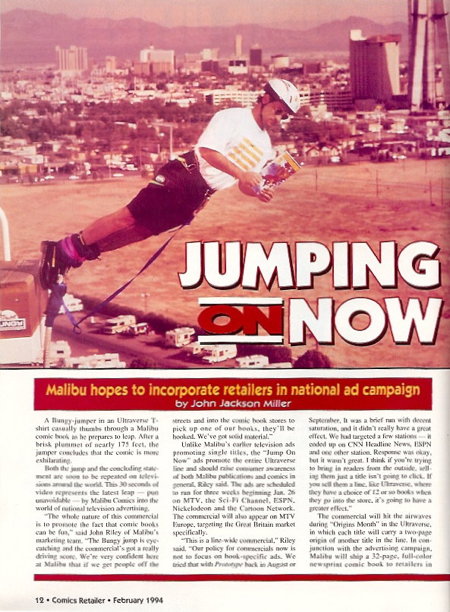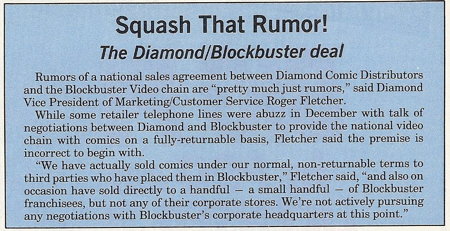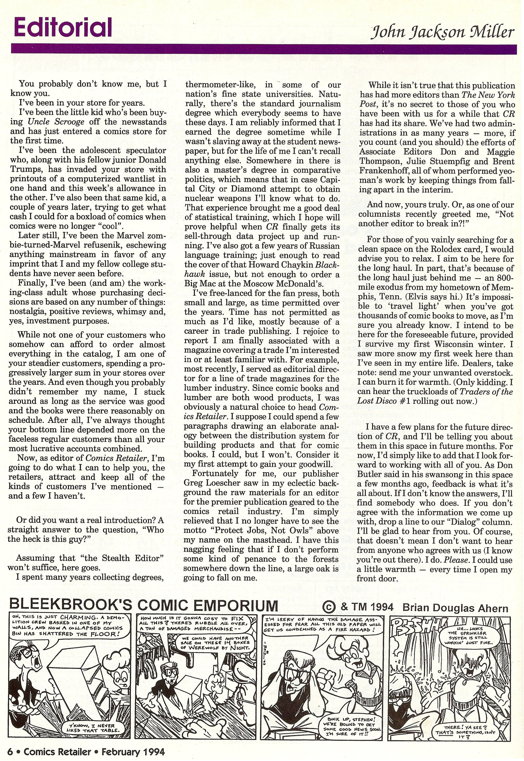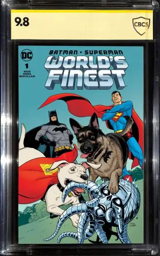Comics Retailer magazine: A personal history
Part 1: Issue #23 (February 1994), produced December 1993
by John Jackson Miller
 As noted in the introduction, on the 23rd of November, 1993, I joined the staff of Krause Publications in Wisconsin, where I began work on the 23rd issue of Comics Retailer, the trade magazine for specialty shops in the comics industry.
As noted in the introduction, on the 23rd of November, 1993, I joined the staff of Krause Publications in Wisconsin, where I began work on the 23rd issue of Comics Retailer, the trade magazine for specialty shops in the comics industry.
Krause was headquartered in a modern building in the small town of Iola. It was not really named after the nosy neighbor in Mama's Family, as I would joke with my friends back home — but it was like something out of a sitcom, in the sense that it was an outpost of obsessives in the middle of nowhere. It was Krause's practice to hire people who were already known and active in their fields; the expectation was that they would remain active, which was why I was able, years later, to begin freelancing as a comics writer while still at the company. So while I shared a workspace with my comics magazine-editing idols, Don and Maggie Thompson, I was within shouting distance of experts in coins, sportscards, record-collecting, guns, and more.
 Indeed, Iola was a case of one man's hobbies transforming a whole town. During my first week on the job, corporate founder Chester "Chet" Krause visited me and gave me a copy of his book, Just Plain Chet. He was as folksy as that title sounded, always approachable — even though his success had clearly allowed him pursuits that were pretty unusual for a tiny burgh in rural Wisconsin.
Indeed, Iola was a case of one man's hobbies transforming a whole town. During my first week on the job, corporate founder Chester "Chet" Krause visited me and gave me a copy of his book, Just Plain Chet. He was as folksy as that title sounded, always approachable — even though his success had clearly allowed him pursuits that were pretty unusual for a tiny burgh in rural Wisconsin.
And his impact on the town was everywhere. The coin collector's magazine he had started at his kitchen table in 1952, Numismatic News, had grown into a publishing company employing more than 400 by my arrival. A Lion's Club gathering Krause staged for fellow old car collectors in 1972 had evolved into the Iola Old Car Show, which in later years grew to occupy hundreds of acres of grounds surrounding the publishing company, drawing vast hordes of collectors to the farmland every July. And by the time I got there, his sale of the company to its employees — Krause had an Employee Stock Ownership Program — had given him the time and resources to commit to his latest hobby: obtaining one of every military vehicle that was in his unit in World War II. That collection would come to inhabit a warehouse alongside the one that held the publishing company's books; a parallel military vehicle show would run for 25 years.
There was much to like — particularly the wonderful antique boarding house which the company made available to me during my move — but all was not idyllic. In my office desk, I found memos between the previous occupant and an executive about the possibility of the editors unionizing. The company was running three shifts in its cavernous production room; the ESOP, I inferred from the letters, was in part intended to blunt the move toward a union. (I would later see corporate checks going out to right-to-work political action committees — for years, my mailroom in-box was right next to the one for accounting!) The exchange of memos had left the former employee disappointed.
I was also greeted with a fax from one of the magazine's longtime advertisers, welcoming me but sounding very critical about the Krause operation in general: saying it was essentially a cash machine first, and that editorial was an afterthought. "Quality only ever happens by accident." I didn't have any illusions about the relative importance of advertising and editorial; heck, editorial content had been added to Comics Buyer's Guide's precursor title, The Buyer's Guide For Comics Fandom, just to get a better postal rate. I knew the situation would be better than my previous publishing company, no matter what. I wrote the advertiser that I disagreed about the level of quality in the magazines — and said I'd take it as a challenge to change his mind. (We did talk about it again after I'd put a few years in; I think I made some headway.)
So I settled in to work on the February cover-dated issue. I actually didn't know it was the 23rd issue when I started, because — somewhat surprisingly for a periodical related to comics — none of the previous issues had issue numbers on the cover. This, of course, could not stand: one of my first decisions was to add issue numbers at the upper left corners of the covers. I even went back and stickered my desk copies of previous issues with the numbers.
The first interviews I did were for a feature on comics for kids, with interviews with Archie's publisher Michael Silberkleit, Gladstone publisher Bruce Hamilton, Antonia Coffman of Bongo, and retailers Buddy Saunders of Lone Star Comics in Arlington, Tex., Michael Reilly of Four Color Fantasies in Morristown, N.J., and Michael McKenzie of Alternate Worlds in Cockeysville, Md. The piece was one of the longer-form ones I did, as eventually I'd farm out the longer features.
 Another color feature I wrote was about Malibu's "Jump On Now!" commercials, which features a Bungy-jumper reading an Ultraverse Comic. The commercial was set to air in January on MTV, the Sci-Fi Channel, ESPN, Nickelodeon, and Cartoon Network. I was never quite clear how a Bungy-jumper could read a comic book, but, hey, it was a fad then. At least he wasn't playing with POGs! (And comics sales were about to fall off a cliff, so it was eerily prescient...)
Another color feature I wrote was about Malibu's "Jump On Now!" commercials, which features a Bungy-jumper reading an Ultraverse Comic. The commercial was set to air in January on MTV, the Sci-Fi Channel, ESPN, Nickelodeon, and Cartoon Network. I was never quite clear how a Bungy-jumper could read a comic book, but, hey, it was a fad then. At least he wasn't playing with POGs! (And comics sales were about to fall off a cliff, so it was eerily prescient...)
The Bunjy ad can be seen in the second half of this clip.
That covered much of my writing contribution — plus the introductory editorial, which appears at the bottom of this page. My other main writing was in the editorial responses to the letters to the editor. And in December 1993's mailbox — still mostly physical with a few faxes — there was no mistaking what the mood of the field was. Retailers were angry.
The year of the late comic book
There was little doubt what had concerned comics retailers most as 1993 wound down: late shipping. Many new publishers had arisen and grown quickly, and many existing publishers had greatly expanded their lines. The result was a huge number of new comics to handle — and a lot of retailer money tied up in orders of books that either hadn't shipped on time, or wouldn't ship at all.
 The Image/Valiant Deathmate crossover event and the launch of Neal Adams' Continuity Comics line had been fraught with problems, the final straws that had ulimately motivated distributors to reduce the cancellation window for titles. Up until December 1993, retailers still had to pay for comics they'd ordered from Diamond Comic Distributors, for example, even if those comics showed up as much as 90 days late. In October, Diamond had announced it was cutting the window back, making more late comics returnable. Capital had also cut back its window, and publishers were rushing out announcements of their own new policies. The Comics Retailer mailbox was filled with angry letters about the situation.
The Image/Valiant Deathmate crossover event and the launch of Neal Adams' Continuity Comics line had been fraught with problems, the final straws that had ulimately motivated distributors to reduce the cancellation window for titles. Up until December 1993, retailers still had to pay for comics they'd ordered from Diamond Comic Distributors, for example, even if those comics showed up as much as 90 days late. In October, Diamond had announced it was cutting the window back, making more late comics returnable. Capital had also cut back its window, and publishers were rushing out announcements of their own new policies. The Comics Retailer mailbox was filled with angry letters about the situation.
The "Market Beat" feature hadn't started yet, but below is what was selling in December 1993; click to see Diamond's charts from the month.

Another letter in the issue would wind up having an outsized effect on my own life: a letter from a retailer in Switzerland complained about the poor sell-throughs that comics titles were seeing. I responded in print that I intended to follow through on a promise made at the magazine's inception, to launch a database of retailer sell-through figures; I included my office phone in my request for volunteers. One of the calls I received in January would be from Meredith Woodwell, then manager at Zanadu Comics in Seattle, Wash.; she would fax a lot of data over the next years, long past the point that the envisioned program was viable. She only stopped in 1996, when I married her.
A big source of material for the magazine in these days would peter out quickly: meeting notes from retailer organizations. The February issue ran the full notes from the Nov. 2 meeting of Comic Book Retailers International's Northern California chapter, which gave me my first chance to publish the comments of Rory Root, Bob Borden, and later columnist Joe Field. The major topic was, again, lateness of issues. CBRI-New York had an attorney at its Nov. 4 meeting, addressing how the Uniform Commercial Code might protect retailers who refused delivery of late products. CBRI-New Jersey had a police sergeant as guest at its Oct. 18 meeting, sharing tips on store safety and security.
The issue includes a retail store photo spotlight and interview I conducted with Brian Schur of Cosmic Comics in Lincoln, Nebr. Such pieces had been a staple in the magazine before my arrival, and while there would continue to be store features over the years, the busy news cycles of the next few years and the addition of market reports would make them less frequent than I would have liked.
A Q&A section included advice on expanding female readership from Rebekah Black of AC Comics and retailer Carol Denbow of Star Clipper Books in St. Louis, Mo.; I'd tour the store later in the year.
All the opinion columns in the issue were solicited before I'd arrived. Bruce Costa continued an extensive interview begun in the previous issue with Dan Hirsch and Charlie Tyson, owners of Legends, a Pennsylvania chain of comics shops. Their warning was that growing too quickly was a danger for retail chains—while they acknowledge that it was a warning that quite a lot of retailers in 1993 had not heeded.
Brian Hibbs looked at publishers' plans for 1994, and found them repetitive. "DC has fallen into the trap that started crippling Marvel half a decade ago: 'If they like it once, they'll love it half a dozen more times!'"
Preston Sweet's column was on what basic stock items every store should have; perfect for his new-retailer target audience. At the time, he said his top-selling basic stock item ever was the Death of Superman trade paperback, which ran just $4.95 at the time.
Bob Gray's column was a holiday-season piece on his life as a comics collector while growing up; he describes new comics as arriving on his newsstands on Tuesdays and later, on Tuesdays and Thursdays.
Bruce Webster provided the second part of a column on upgrading professionalism in the industry, focusing on fair treatment of customers when it came to pricing and other matters.
Kit Kiefer, a former Krause employee, provided a column on marketing trading cards, which were still hot at that time; regular columns about specific product areas like cards, toys, and anime would drift in and out of the magazine during my tenure, with game coverage eventually expanding to rival comics for space.
The Punchline column faced the inside back cover, and was always a guest column or interview; the guest for the month was an interview by Costa of Ivan Snyder, founder of Heroes World Distribution (and Costa's employer, at that time); Snyder was also president of the International Association of Direct Distributors, a group that, ironically, would implode a little over a year later as Snyder sold his company to Marvel.
Snyder pulled few punches about the state of the market in late 1993: "The outlook for the immediate future is bleak," he said, following a glut of product and the cyclical trend toward people underbuying after they've overbought. "I feel there will definitely be attrition in January," he said, noting that the Christmas season to that point had been bad. "In all probability, those retailers who are holding on, hoping for a good holiday season to get them partially out of their bind and make them last, will not have that happen." (His predictions would prove true.) Fewer titles and timely shipping were his recommendation.
 Finally, a sign of the times: we ran a "Squash that Rumor!" piece in which Roger Fletcher of Diamond denied reports of any linkage between the distributor and Blockbuster Video. Diamond had sold comics to accounts that had placed them in Blockbuster, he said, and occasionally to a small number of franchisees, but nothing corporate-wide was in the works.
Finally, a sign of the times: we ran a "Squash that Rumor!" piece in which Roger Fletcher of Diamond denied reports of any linkage between the distributor and Blockbuster Video. Diamond had sold comics to accounts that had placed them in Blockbuster, he said, and occasionally to a small number of franchisees, but nothing corporate-wide was in the works.
Producing the magazine
A bit, now, about the mechanics of publishing in 1993, as it will become relevant in some later months. In the days before full electronic pagination, most newsrooms used front-end video display terminals that connected to typesetting machines. Displaying copy on screen in either green-and-white or black-and-white, the monitors offered absolutely no bells or whistles; even italics did not display as italic on the front-end. I'd used such systems at my college newspaper and the lumber magazines; my last act there had been to work with the publisher to get everything changed out to Macintoshes. I got to use them for exactly a month when I moved to Krause — and, once again, back to an old front-end system.
Only... worse. Whirlwind had been developed for the Houston Chronicle in 1988; in 1989 it had been acquired along with other Camex holdings by Dupont. I had always heard that, as a guinea-pig for the service, Krause Publications had gotten it cut-rate; whatever it was, we were paying too much. The Thompsons' struggles with the system had become legend in the company, given how much copy they were churning out weekly. Whole stories would disappear into the system, bound for who-knows-where in the electronic ether. The running office joke was that Dupont's publishing system was itself a chemical weapon. (Eventually, the conglomerate would divest itself of Whirlwind, forcing Krause and other publishers to try to prop up the service while looking for an alternative.)
Magazine output was still cut-and-paste layout on paste-up boards, just like I'd done on my high school newspaper. It did not seem like a particularly modern way to publish in 1993, but — hey! — at least the stories were about comics. It felt like running my own fanzine again.
A couple of weeks before the magazine went to press came the ad deadline — and my first layout meeting. Krause Publications' "shopper" titles, like Comics Buyer's Guide, were majority-advertising in the 1980s and 1990s. The placement of ad spots in those magazines were handled by ad sales assistants; editors, like the Thompsons, were presented with a "newshole," or grid of specific pages were theirs to fill. Comics Retailer's formula was that editorial received one page for every page of advertising sold, so there were fewer ads to place — and the publication was complicated by the fact that only certain signatures (or sections) were in full or partial color, again triggered by the sale of ads with a color upcharge. I wouldn't know how much color would be in the magazine — or even how many pages it would be — until the sales deadline.
The issues were complex enough that Jim Owens, the new lead advertising representative on the magazine, and I began meeting monthly to "fill in the blanks" on the layout grid, with him lobbying for better placements for particular advertisers, and me lobbying for whatever space would make the editorial most presentable to readers. The meetings, sometimes raucous, would become a vital part of the success of the publication during the next several years — a period during which other comics magazines were faltering. While I talked with several businesses in the industry each month, Owens and his fellow reps called everyone — and so he could often offer me intel on how various firms were faring.
And, yes, the ad side did serve as a conduit for companies to tell us about what they wanted to see in the magazine, though I was never obligated to follow up on any suggestions, and it was a far cry from my previous lumber magazine experience, which was fully pay-to-play, with advertisers even getting line-check approval over every mention of their firms. This was not that.
Color, I discovered, was rare in Krause magazines in general — and very difficult to handle. All full color pages had to go through the art department, and our assigned artist, Al West — even when the page only needed a single picture placed. That was where all the Macintoshes were; no editors yet had them. It wouldn't be long before I was making so much use of color that the whole production scheme would need to be rethought — but that lay in the future. The first issue went to press, on time, just before my first Christmas in Wisconsin.
It was during the down week before New Year's, however, that one of the most meaningful events for the magazine happened. Owens, a gamer, introduced me and associate editor Brent Frankenhoff to Magic: The Gathering, a new kind of "collectible" card game introduced the previous summer at Origins. An admirer of great game design myself, I was blown away. The system seemed endlessly replayable, and it not only encouraged, but rewarded something that sportscard collectors had more or less stopped doing: trading. I was even more enamored of the gambling dynamic: at the time, the practice still was that cards placed as "ante" literally were at risk to being claimed by victorious players. Everything about it suggested that it would be the perfect product for game stores, trading-card stores, and yes, many comics stores as they prepared to get through 1994.
And as that year began, it became clear they would need every penny from it, and more...
Next month: 1994 begins with an earthquake — and a catastrophe for comics retailing.
Comics Retailer #23 editorial
by John Jackson Miller
 You probably don't know me, but I know you.
You probably don't know me, but I know you.
I've been in your store for years.
I've been the little kid who's been buying Uncle Scrooge off the newsstands and has just entered a comics store for the first time.
I've been the adolescent speculator who, along with his fellow junior Donald Trumps, has invaded your store with printouts of a computerized wantlist in one hand and this week's allowance in the other. I've also been that same kid, a couple of years later, trying to get what cash I could for a boxload of comics when comics were no longer "cool". Later still, I've been the Marvel zombie-turned-Marvel refusenik, eschewing anything mainstream in favor of any imprint that I and my fellow college students have never seen before.
Finally, I've been (and am) the working-class adult whose purchasing decisions are based on any number of things: nostalgia, positive reviews, whimsy and, yes, investment purposes.
While not one of your customers who somehow can afford to order almost everything in the catalog, I am one of your steadier customers, spending a progressively larger sum in your stores over the years. And even though you probably didn't remember my name, I stuck around as long as the service was good and the books were there reasonably on schedule. After all, I've always thought your bottom line depended more on the faceless regular customers than all your most lucrative accounts combined.
Now, as editor of Comics Retailer, I'm going to do what I can to help you, the retailers, attract and keep all of the kinds of customers I've mentioned - and a few I haven't.
Or did you want a real introduction? A straight answer to the question, "Who the heck is this guy?"
Assuming that "the Stealth Editor" won't suffice, here goes.
I spent many years collecting degrees, thermometer-like, in some of our nation's fine state universities. Naturally, there's the standard journalism degree which everybody seems to have these days. I am reliably informed that I earned the degree sometime while I wasn't slaving away at the student newspaper, but for the life of me I can't recall anything else. Somewhere in there is also a master's degree in comparative politics, which means that in case Capital City or Diamond attempt to obtain nuclear weapons I'll know what to do. That experience brought me a good deal of statistical training, which I hope will prove helpful when CR finally gets its sell-through data project up and running. I've also got a few years of Russian language training; just enough to read the cover of that Howard Chaykin Blackhawk issue, but not enough to order a Big Mac at the Moscow McDonald's.
I've free-lanced for the fan press, both small and large, as time permitted over the years. Time has not permitted as much as I'd like, mostly because of a career in trade publishing. I rejoice to report I am finally associated with a magazine covering a trade I'm interested in or at least familiar with. For example, most recently, I served as editorial director for a line of trade magazines for the lumber industry. Since comic books and lumber are both wood products, I was obviously a natural choice to head Comics Retailer. I suppose I could spend a few paragraphs drawing an elaborate analogy between the distribution system for building products and that for comic books. I could, but I won't. Consider it my first attempt to gain your goodwill.
Fortunately for me, our publisher Greg Loescher saw in my eclectic background the raw materials for an editor for the premier publication geared to the comics retail industry. I'm simply relieved that I no longer have to see the motto "Protect Jobs, Not Owls" above my name on the masthead. I have this nagging feeling that if I don't perform some kind of penance to the forests somewhere down the line, a large oak is going to fall on me.
While it isn't true that this publication has had more editors than The New York Post, it's no secret to those of you who have been with us for a while that CR has had its share. We've had two administrations in as many years - more, if you count (and you should) the efforts of Associate Editors Don and Maggie Thompson, Julie Stuempfig, and Brent Frankenhoff, all of whom performed yeoman's work by keeping things from falling apart in the interim.
And now, yours truly. Or, as one of our columnists recently greeted me, "Not another editor to break in?!"
For those of you vainly searching for a clean space on the Rolodex card, I would advise you to relax. I aim to be here for the long haul. In part, that's because of the long haul just behind me - an 800-mile exodus from my hometown of Memphis, Tenn. (Elvis says hi.) It's impossible to 'travel light' when you've got thousands of comic books to move, as I'm sure you already know. I intend to be here for the foreseeable future, provided I survive. my first Wisconsin winter. I saw more snow my first week here than I've seen in my entire life. Dealers, take note: send me your unwanted overstock. I can burn it for warmth. (Only kidding. I can hear the truckloads of Traders of the Lost Disco #1 rolling out now.)
I have a few plans for the future direction of CR, and I'll be telling you about them in this space in future months. For now, I'd simply like to add that I look forward to working with all of you. As Don Butler said in his swansong in this space a few months ago, feedback is what it's all about. If I don't know the answers, I'll find somebody who does. If you don't agree with the information we come up
with, drop a line to our "Dialog" column. I'll be glad to hear from you. Of course, that doesn't mean I don't want to hear from anyone who agrees with us (I know you're out there). I do. Please. I could use a little warmth — every time I open my front door.
(2018 notes: An issue of Uncle Scrooge is the first comic book I remember reading, hence its namecheck. Traders of the Lost Disco was the imaginary speculator-bait comic book from Raoul Vezina's great Smilin' Ed comics story in Fantaco's X-Men Chronicles. And no, after 25 years, I never did get used to the winters—though I did survive them!)









